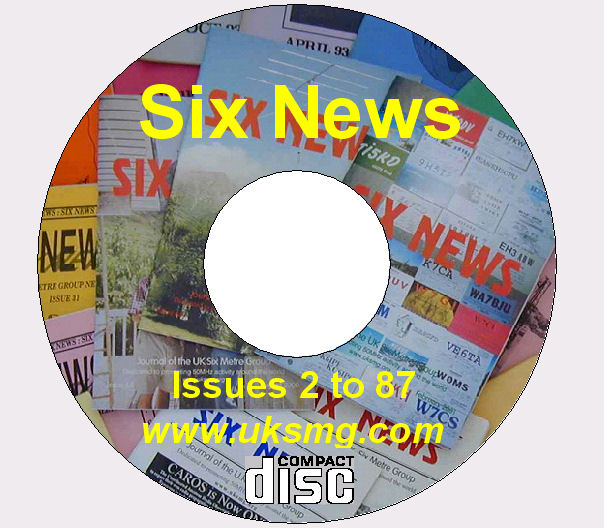|
Early Days
Six metre history begins towards the end of World War Two when
the Federal Communications Commission announced the frequencies
to be used for FM and television in USA (ref.):
|
OLD |
NEW |
| 42-50 |
FM |
42-44 |
Exp. Police |
| 50-56 |
TV |
44-50 |
TV |
| 56-60 |
Amateur |
50-54 |
Amateur |
| 60-66 |
TV |
54-60 |
TV |
| 66-72 |
TV |
60-66 |
TV |
 G3COJ's
original 1948 permit (click to enlarge) G3COJ's
original 1948 permit (click to enlarge)
In the 1930s, transatlantic signals had been received in both
directions on the five metre band (56-60MHz) but no two-way
contact took place. The late 1940s were a period of high sunspot
activity and prospects for the six metre band, 6MHz lower, were
good. The FM band was moved to 92-106MHz (later 88-108) and
stations began testing on the new band on 1st December 1945.
However, the old band continued in use until sufficient receivers
for the new band were in the hands of the public. In fact, 44-50
MHz was never used for television but given over to PMR, police
and suchlike services.
 The
1948 general 50-54Mc/s permit (click to enlarge) The
1948 general 50-54Mc/s permit (click to enlarge)
The transatlantic MUF was often above 40MHz and I well
remember managing to identify WGTR, Boston, 44MHz, on my
two-valve super-regenerative receiver. It would be only a matter
of time before six metre American amateurs would be heard in UK.
The breakthrough came on 24 November 1946 when G5BY and G6DH
heard W1HDQ, West Hartford, Conn., on 50.003MHz. Both stations
made cross-band contacts from 28MHz.
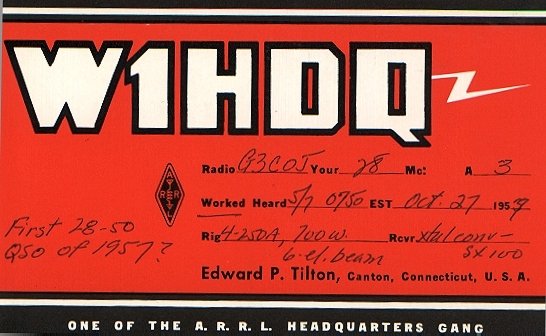
WIHDQ,
Ed Tilton, then QST VHF Editor, whom became a silent key earlier
this year at the age of (I think) 88. Note his kind words on the
back of the card (see below).
Interest in Europe for 50MHz transmission permits was
considerable. One of the first was PAĜUN, who was heard in South
Africa on 26 March 1947. In the UK, the GPO agreed to the issue
of six metre permits to a limited number of G stations from 5
November 1947. Some ill feeling was caused by the omission of
several active VHF stations from the list, but this was soon
rectified. In fact the first, unofficial, two-way transatlantic
contact had already been made by a station signing
"G6X". One may speculate on the identity of
"G6X" but G6NA recalls being on the receiving end of
GPO enquiries about the matter. (For those not familiar with
Morse, the letter "N" and "A" run together
form "X").
The first legitimate contacts from UK were as follows :-
| Canada |
G5BD/VE1QZ |
1620 |
5.11.47 |
| Canal Zone |
G6DH/MD5KW |
0855 |
10.11.47 |
| Egypt |
G5BM/SU1HF |
0900 |
16.11.47 |
| France |
G6DH/F8ZF |
2035 |
10.12.47 |
| Netherlands |
G6DH/PAĜUN |
0750 |
10.3.48 |
| South Africa |
G5BY/ZS1P |
1239 |
6.11.47 |
| U.S.A. |
G6DH/W1HDQ |
1302 |
5.11.47 |
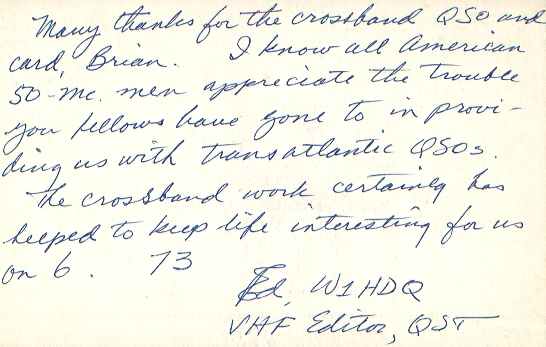
Ed's comments on the
back of G3COJ's QSL.
MD5KW was operated by Ken Ellis, G5KW, well known to
present-day 50MHz operators. In early 1948, the GPO agreed to the
issue of six metre permits to any amateur on payment of ten
shillings. These permits were only valid until 30th April 1948,
but were later extended to 31st December 1948.
The IGY
After this, Band 1 405-line television spread rapidly, with
the first transmitter outside London, at Sutton Coldfield,
opening in 1949, followed by many others in due course.
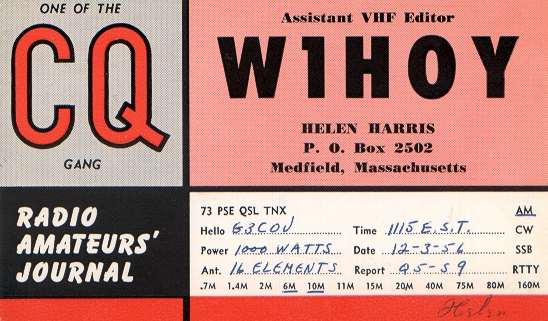
WIHOY, Helen
Harris, wife of Sam Harris, WIFZJ She was always on and was the
VEIYX of the time. Sam was appointed to be in charge of the
Arecibo, Puerto Rico, radio telescope but died soon after taking
up office. Helen continued as W1HOY/KP4, but died many years ago.
During the high sunspot activity in the late nineteen-fifties
contacts were limited to cross-band operation from ten metres.
However, during the International Geophysical Year (1957/8) the
GPO agreed that, for a period of six months, amateurs in certain
areas (Northumberland, Monmouthshire, Glamorgan and parts of the
Western Islands and Highlands of Scotland) could apply for
permission to operate on 52.5MHz with a power input not exceeding
500 watts. In other parts of the country, operation would be
permitted between 0100 and 0930 GMT. Little or nothing happened
between 0100 and 0930 but G4LX (Newcastle-upon-Tyne), having no
time restriction, made many contacts, his main difficulty being
to get stations to listen as high as 52.5 MHz. He worked HB, OH,
VE, W and ZE but, unfortunately, his permit expired on 31st
October before the transatlantic path was fully open.
Hopes raised
In autumn 1980 the RSGB was asked at short notice to provide a
list of twenty-five amateurs who would be interested in permits
to transmit on six metres and the VHF Manager Tom Douglas, G3BA
(who is now a silent key) did so. It was conjectured that an
announcement would be made at the IARU Region 1 conference in
Brighton the following spring. The licensing authority, the Home
Office, was agreeable but the BBC, when they found out, objected
and the proposal came to nothing. One might wonder why the BBC
should be concerned, but, at that time, a reserve vision feed to
a station could be obtained off-air in case of failure of the
normal link. For example, the station at Llanddona in Anglesey
could receive the channel 2 signal from Holme Moss and 50MHz
transmissions might cause a problem.
In 1980 a proposal was also made for a 50MHz beacon, GB3SIX,
to be established in Anglesey beaming west to give an indication
if the transatlantic path was open. An immaculate case, based on
that for the French beacon FX3THF at Lannion, was prepared,
showing that it would cause no interference to television
reception. However, the Home Office only licensed it for
operation outside television hours, which completely negated its
usefulness.
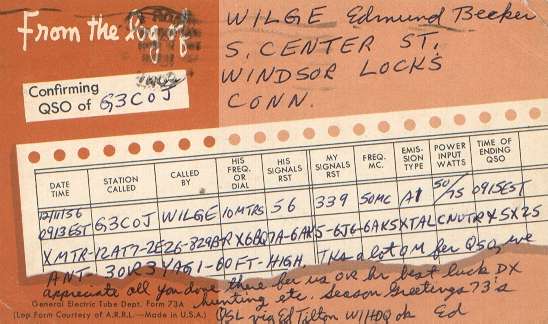
By 1982 the situation was very
different. The UK Six Metre Group had been founded by Steve,
G4JCC, to promote interest in the band. 405-line television was
in decline and would cease at the end of 1984. Responsibility in
the BBC for liaison with the licensing authority lay with the
Engineering Information Department, in particular, the assistant
head of that department. The previous holder of that post had
retired and been succeeded by one Phil Laven, who was more
sympathetic to amateurs.
Enter at this point, spring 1982, Jim Sleight, G3OJI. Although
not a six metre man - his forte was Raynet - as a senior BBC
engineer he knew all the interested parties and it was largely
thanks to him that six metre permits were issued. As a result, a
meeting took place at the BBC Engineering Information Department
in June 1982 at which Phil Laven, Jim Sleight (G3OJI), David
Evans (G3OUF, General Manager of the RSGB), and G3COJ, were
present. The BBC agreed to 50MHz operation on a
no-interference-to-television basis and the Home Office was
informed accordingly.
Permits at last
In the autumn of 1982, the Home Office invited applications
for forty six metre permits. Those who applied received a
fearsome questionnaire based on a draft by G3COJ and G5KW and
intended to deter the faint-hearted. Nevertheless some three
hundred applications were received. The RSGB VHF Manager, by then
Keith Fisher, G3WSN, sent a list to the Home Office of those
amateurs who would be likely to make effective use of permits but
it was stressed that this was only advisory and the choice lay
with the Home Office. So it proved and one successful applicant
is thought never to have shown any practical interest in the band
before or since - a source of some ill feeling. In December 1982
they allowed 24-hour operation of GB3SIX and it went on to become
an effective propagation indicator.
After that, events moved rapidly. The lucky applicants, of
whom I was one, received their permits in late January 1983,
allowing operation outside television hours from 1st February
onwards with the same power limit as on 70MHz . In the hope of
being successful I had put together a transverter and modified an
old two-metre linear to work on six.
Just after midnight, as the last notes of ‘God Save The
Queen’ on BBC1 died away, I put out a CQ, followed by
another and another. After about twenty minutes, I realised I
still had the dummy load connected. I transferred to the yagi and
was immediately answered by G4JLH, Harold Rose, Chairman of the
UK Six Metre Group, for my first ever six metre contact. Sadly,
four years later, Harold became a silent key at the early age of
35.
Matters progressed steadily. ‘Outside television
hours’ was defined as between 2330 and 0830 clock time and
this was fairly rigidly adhered to. In the summer of 1983 late
night multi-hop Es transatlantic contacts were made. Ken Ellis,
G5KW, camped out in the Scilly Isles for several months and was
rewarded with many interesting QSOs, including the first UK to
Gibraltar.
In October 1983, after background work by G3OJI and G3COJ, the
BBC agreed to 24-hour operation of all the permit holders, except
one. The off-air receiver at Llanddona was no longer needed as
the incoming 625-line signal could be converted to 405 lines if
necessary. On 26 October the BBC wrote accordingly to the
licensing authority, now the Department of Trade and Industry.
However, this was the first the DTI had heard of the proposal and
they turned it down.
In February 1984 it was stated that a further 60 permits would
be issued, bringing the total to 100. The callsigns of the
successful applicants were announced in January 1985.
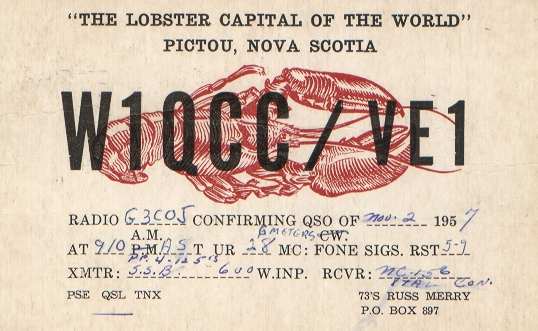
All operation was
on AM (or CW) with no SSB, with the sole exception of W1QCC/VE1
His SSB was difficult to copy with mv RF26 Unit with its tunable
oscillator. He is listed as WlQCC in the 1992 Call Book.
General release
In June 1985, the Minister of State for Industry and
Technology stated in Parliament that the band 50 to 50.5MHz was
to be allocated to the UK amateur service. After a long period of
negotiation between the RSGB and the DTI, it was announced that
Class A licensees would be permitted to use 50 to 50.5MHz
starting at 0001 on 1st February 1986. The experimental permits
were withdrawn and the time restrictions removed. However, a
power limit of 100 watts erp on SSB (25W on CW) was imposed and
aerial height was restricted to 20 metres above ground with only
horizontal polarisation. Full details are given in Radio
Communication for January 1986.
Class B licensees thought they were being discriminated
against, but, in reality, the DTI was being cautious. These
frequencies were still used by European television stations and
there was a possibility of interference to them, in particular
the station in Belgium at Ostend. However, the fears were
unfounded and 50MHz and also 70MHz were released to Class B
licensees on 1st June 1987. The band was extended to 50.000 to
52.000MHz. At the same time the four metre allocation was
increased to 70.000 to 70.500MHz. In my case the 4CX250B
amplifier I had used in the permit days was stored in the loft
and the 25 watt amplifier I had started with in 1983 reactivated.
With this arrangement I made WAC and DXCC.
Restrictions were gradually relaxed. Vertical polarization and
mobile operation were permitted from 5th April 1991 onwards.
Finally, on 18th July 1994, the ERP limit and aerial height
restriction were removed and a power of 400 watts permitted
between 50 and 51MHz with primary status for the Amateur Service
on the basis of non-interference to other services outside the
United Kingdom. 51 to 52MHz had secondary status and a power of
100 watts. I recovered my 4CX250B amplifier from the loft and
eventually got it going again.
The UKSMG played a role in all this. UKSMG
stalwart Ken Ellis, G5KW, was a member of the RSGB VHF Committee
and kept up the pressure on it and the RSGB for results, which
were eventually achieved, as described here.
What of the future? 50 to 51MHz has the same power limit as
the HF bands so there is no relaxation to be made there.
Repeaters have now been licensed. We can look forward to an
interesting time in sunspot cycle 23, which is just beginning.
Reference: Radio Craft (Gernsback Publications), December
1945, page 163.
UKSMG Six News issue
54, August
1997 |
|


